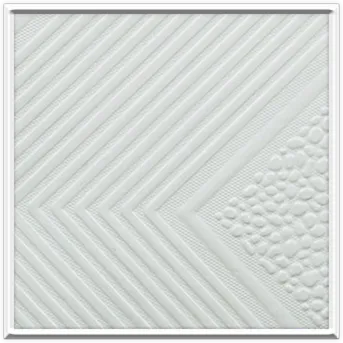- Afrikaans
- Albanian
- Amharic
- Arabic
- Armenian
- Azerbaijani
- Basque
- Belarusian
- Bengali
- Bosnian
- Bulgarian
- Catalan
- Cebuano
- Corsican
- Croatian
- Czech
- Danish
- Dutch
- English
- Esperanto
- Estonian
- French
- German
- Greek
- Hindi
- Indonesian
- irish
- Italian
- Japanese
- Korean
- Lao
- Malay
- Myanmar
- Norwegian
- Norwegian
- Polish
- Portuguese
- Romanian
- Russian
- Serbian
- Spanish
- Swedish
- Thai
- Turkish
- Ukrainian
- Uzbek
- Vietnamese
Pro . 03, 2024 11:25 Back to list
suspended ceiling access panel
Understanding Suspended Ceiling Access Panels An Essential Guide
In modern architecture and interior design, suspended ceilings have become a popular choice due to their aesthetic appeal and practicality. They offer a seamless way to conceal plumbing, electrical wiring, and HVAC systems while creating an illusion of height in a room. One crucial element of these ceilings is the access panel, specifically designed for maintenance and inspection needs. In this article, we will explore what suspended ceiling access panels are, their types, benefits, installation process, and best practices for maintenance.
What is a Suspended Ceiling Access Panel?
A suspended ceiling access panel is a removable section of a ceiling that provides quick and easy access to the space above it. This panel is typically installed in a grid system that holds the ceiling tiles in place. The primary purpose of these panels is to allow maintenance personnel to reach the mechanical and electrical systems hidden above the ceiling without having to remove large sections of the ceiling.
Types of Access Panels
There are several types of access panels designed for suspended ceilings, each serving different functions and preferences. Below are the common types
1. Drop-In Access Panels These panels are designed to drop into the ceiling grid. They are often easy to install and can be removed with minimal effort. This is a popular choice for commercial spaces, where frequent access is required.
2. Lift-Out Access Panels Similar to drop-in panels, these can be lifted out completely. They typically have a removable frame that allows for easy access but may require a bit more effort to reinstall than drop-in models.
3. Hinged Access Panels These panels have hinges that allow them to swing open, providing easy access to the space above. They are particularly useful in situations where frequent access is necessary without the risk of losing the panel.
4. Fire-Rated Access Panels For areas that require compliance with fire safety regulations, fire-rated access panels are designed to contain fire and smoke moving through ceilings. These panels are built with durable materials that can withstand high temperatures.
5. Insulated Access Panels These panels are insulated to prevent heat loss or gain, making them ideal for HVAC systems. They help maintain energy efficiency in a building.
Benefits of Access Panels
The installation of suspended ceiling access panels offers several benefits
- Easy Maintenance Access panels allow for quick access to electrical systems, plumbing, and other utilities, facilitating timely repairs and maintenance.
- Improved Aesthetics By allowing for maintenance without the need for extensive demolition or renovation, access panels help maintain the visual integrity of a space.
- Compliance and Safety Certain areas require access panels to meet building codes and safety regulations, ensuring that spaces remain compliant with local laws
.suspended ceiling access panel

- Cost-Effective Solutions While they may incur initial installation costs, access panels can save significant amounts of time and money in maintenance over the life of the building.
Installation Process
Installing access panels in a suspended ceiling involves several steps
1. Planning Identify the locations where access is necessary based on the utilities above the ceiling, ensuring easy reach without obstructing any systems.
2. Measurement Measure the panels that will be installed, ensuring they fit well within the grid system of the ceiling.
3. Cutting If not pre-fabricated, cut out the necessary sections of the ceiling tiles for installation.
4. Framing Secure a frame for the access panel, ensuring it is firmly attached to the supporting structures.
5. Installation Fit the access panel into place, ensuring it sits level with the surrounding ceiling tiles.
6. Finishing Touches Apply any additional paint or finishes required to match the aesthetics of the ceiling.
Maintenance Best Practices
To ensure that suspended ceiling access panels remain functional and aesthetically pleasing, regular maintenance is important. Here are some best practices
- Regular Inspections Periodically check access panels for any signs of wear or damage. Address any issues immediately to avoid larger problems.
- Cleaning Keep the panels clean and free from debris to maintain their appearance and functionality.
- Ensure Proper Sealing If using insulated or fire-rated panels, ensure that seals are intact to prevent energy loss or fire hazards.
In conclusion, suspended ceiling access panels are crucial components in modern building design that provide functionality, aesthetics, and regulatory compliance. Whether in commercial or residential spaces, understanding their types, benefits, and maintenance can help in creating effective and well-maintained environments.
-
Transform Interiors with PVC Gypsum Ceiling: A Stylish, Durable, and Moisture-Resistant SolutionNewsMay.19,2025
-
The Smart Interior Upgrade: Discover the Durability and Versatility of Gypsum Ceiling Access Panel SolutionsNewsMay.19,2025
-
The Smart Choice for Interior Design: Discover the Value of PVC Gypsum Ceiling SolutionsNewsMay.19,2025
-
Mineral Fiber Ceiling Tiles: The Smart Blend of Performance and AestheticsNewsMay.19,2025
-
Mineral Fiber Ceiling Tiles: The Superior Choice Over Gypsum for Sound and Fire SafetyNewsMay.19,2025
-
Mineral Fiber Ceiling Tiles: Eco-Friendly Strength and Style for Every CeilingNewsMay.19,2025







